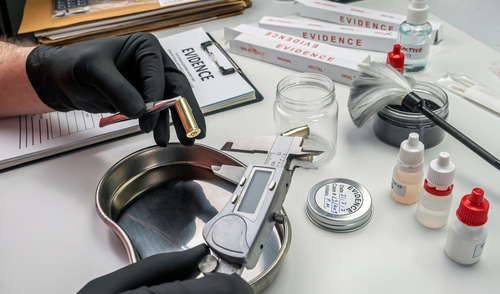Expert can’t offer ‘unqualified opinion’ that crime scene bullets match suspect’s gun, top state court says

Maryland is one of the first jurisdictions in the country in which an appeals court has imposed limits on the use of bullet-match testimony after recognizing shortcomings in the practice. Image from Shutterstock.
A ballistics expert can testify that bullets at a crime scene are consistent with patterns on bullets fired from a suspect’s gun but can’t offer an “unqualified opinion” of a match, the Maryland Supreme Court ruled Tuesday.
Maryland is one of the first jurisdictions in the country in which an appeals court has imposed limits on the use of bullet-match testimony after recognizing shortcomings in the practice, the Baltimore Sun reports.
The state supreme court ruled 4-3 for the defendant, Kobina Ebo Abruquah, who was convicted for the August 2012 shooting death of his roommate. After his first murder conviction was reversed, Abruquah was convicted a second time.
At Abruquah’s retrial, a firearms expert testified that four bullets and a bullet fragment at the crime scene “at some point had been fired from” a Taurus .38 revolver owned by Abruquah.
Testimony by a jailhouse informant was also read into the record. The informant said Abruquah told him that he shot his roommate with “a 38” after Abruquah “snapped” during a heated argument.
The ballistics expert made “an unqualified statement that the bullets were fired from Mr. Abruquah’s revolver,” the Maryland Supreme Court majority said. The conclusion is “more definitive than can be supported by the record.”
The state supreme court said the state’s expert could testify, however, “whether the patterns and markings on the crime scene bullets are consistent or inconsistent with the patterns and markings on the known bullets” fired from the revolver.
Firearms identification is based on the premise that no two guns will make identical marks on a bullet or cartridge case, the Maryland Supreme Court explained. The unique marks are said to be the result of a manufacturing process that involves cutting, drilling, grinding, hand filing and sometimes hand polishing.
But scientific reports have criticized the evaluation system developed by the Association of Firearm and Tool Mark Examiners, according to the state supreme court.
The evaluation protocols don’t address how many points of similarity are needed for a given level of confidence in a match, according to a 2009 report by the National Research Council of the National Academies of Science.
And the methods used in ballistics analysis have not been validated in properly conducted studies that show them to be repeatable, reproducible and accurate, according to the 2009 report and a 2016 report by the President’s Council of Advisors on Science and Technology.
One proper study validated the methods used, but it was not published in a scientific journal and has not been subjected to peer review, according to the 2016 report. In that study, 218 examiners reviewed 15 sets of four cartridge cases fired from 25 new, same-model handguns using the same type of ammunition.
The error rates in that study and in a second follow-up study were “in the low single digits,” the Maryland Supreme Court said. The percentage of results classified as inconclusive was higher than in other, less reliable studies, however.
A former FBI lab expert who testified for Abruquah said firearms identification doesn’t follow the scientific method and lacks guidance for examiners to determine the number of similarities needed to identify a match. In addition, the expert testified, examiners ignore or “rationalize away” dissimilarities in samples.
An expert for the state said the ballistics matching method had been accepted by the relevant scientific community and by the courts, and it has been proven by numerous studies.
Whether the ballistics matching method is generally accepted “is largely dependent on what the relevant community is,” the Maryland Supreme Court said. Firearms identification experts overwhelmingly support the methods used. “Groups of eminent scientists and other academics,” on the other hand, “have been critical of the absence of studies demonstrating the validity of firearms identification generally” and the testing methodology specifically.
“We would be remiss were we to rely exclusively on a community that, by definition, is dependent for its livelihood on the continued viability of a methodology to sustain it while ignoring the relevant and persuasive input of a different, well-qualified and disinterested segment of professionals,” the state supreme court said.
“On balance,” the state supreme court said, the evidence “weighs against admission of testimony of a ‘match’ between a particular firearm and a particular crime scene bullet.”
The court vacated Abruquah’s conviction and remanded for a retrial.
Write a letter to the editor, share a story tip or update, or report an error.



